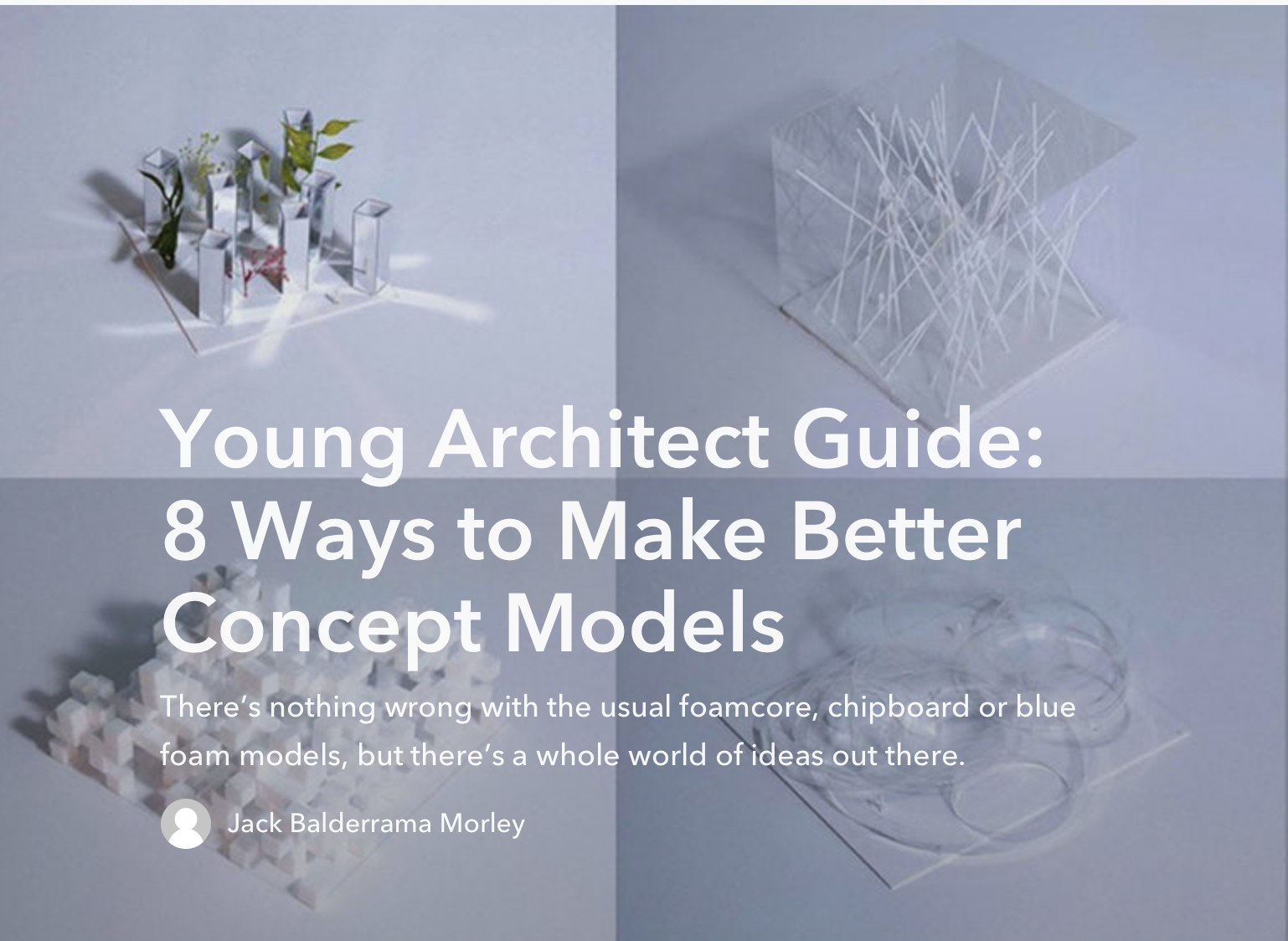CONTACT-LINKS-ARTICLES-PRESS
contact
-----------------------------------------------
Send me an email // click here
about
-----------------------------------------------
studio
-----------------------------------------------Vjeko Sager
STUDIO 332
Parker 1000
Vancouver,BC
external links
-----------------------------------------------Drawing Room / website
Blog / Artosophia
Academia.edu / Vjeko Sager
PUSH Festival for Performing Arts / Ryeberg 2014
YouTube
Drawing Club
-------------------------------------
Emily Carr University Drawing Club
Drawing Room promotes drawing culture by bringing together participants form diverse backgrounds, skills and expertise. Drawing Room provides an inspiring creative platform for encounters, artistic research and drawing experimentaton.
Facilitated by Vjeko Sager
CURAtorial
--------------------------Art in Exile

Artropolis 2003 // curatorial essay by Vjeko Sager


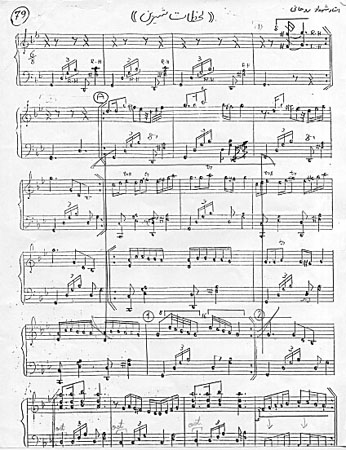
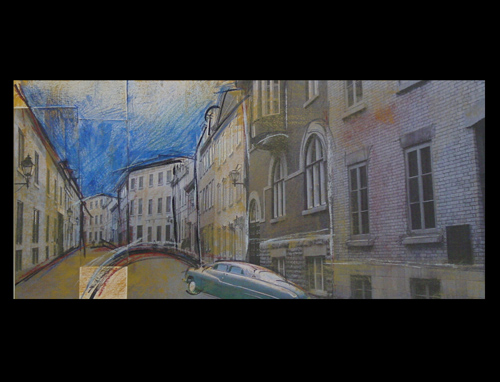

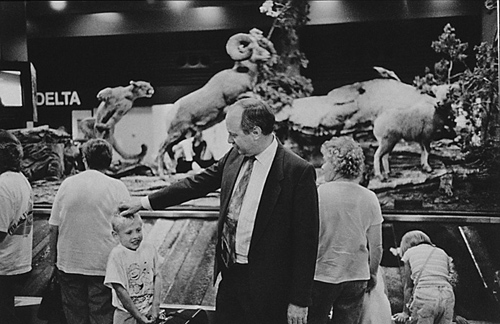
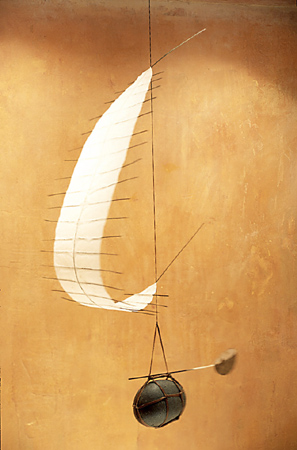






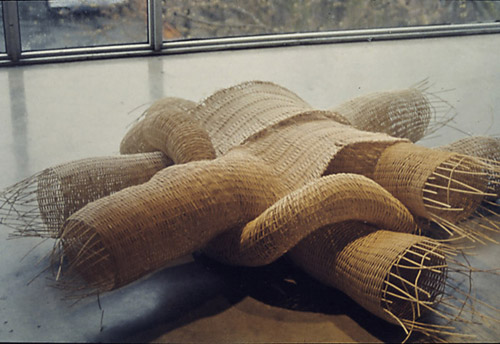


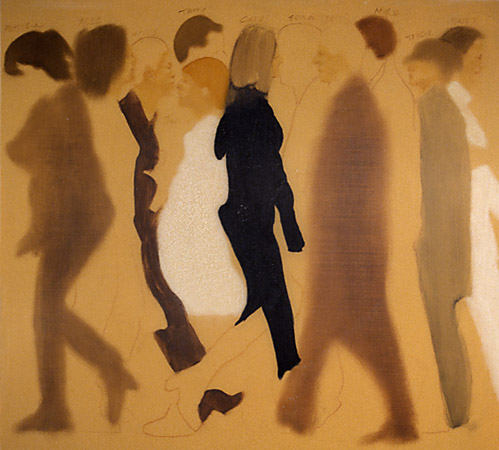

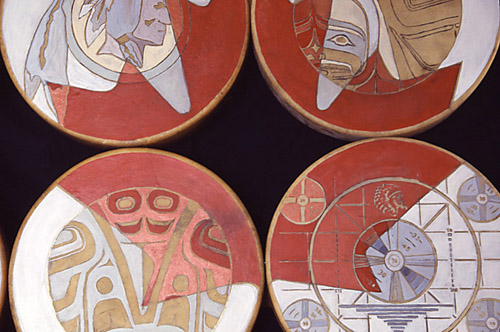

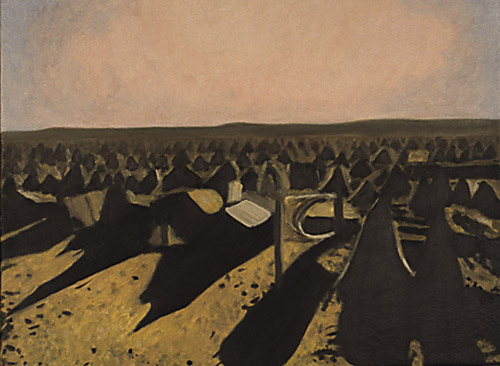
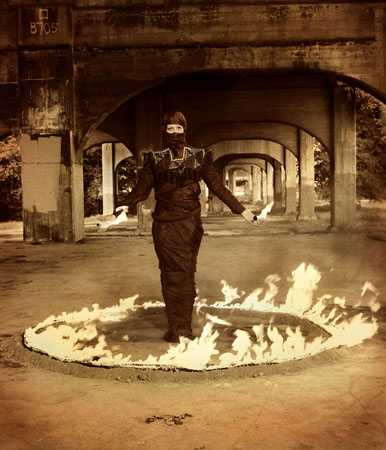
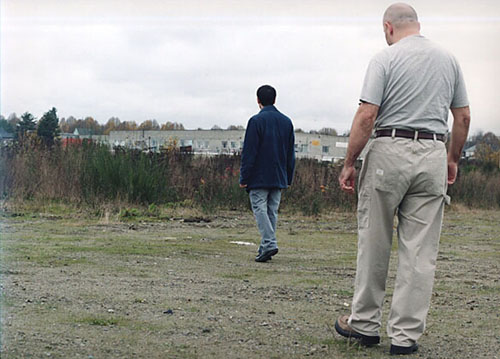

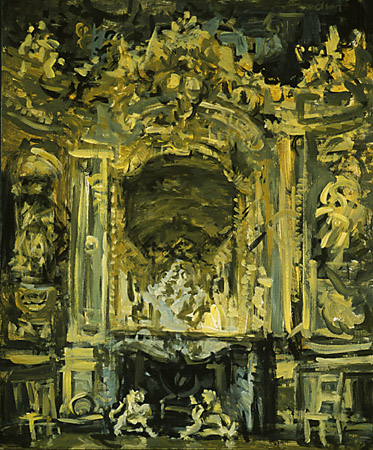
Vjeko Sager curated the “Art in Exile” for Artropolis 2003, visited by more than ten thousand visitors at the CBC Studios in Vancouver. He selected 25 artists form British Columbia who declared to be in exile. Curatorial statement: Exile is a state of mind.
YK Festival 2014
Feature artist Vjeko Sager
Vjeko Sager / living on a tower for a 7 days
Essay by Yun-Jou Chang
INFLUENCE:R
----------------------------------
How Vjeko Sager’s works inspire artists, architects, designers and photographers
NEWS + interviews
-----------------------------------------------Vancouver Sun
/ diviNation 2014Vjeko Sager: sharing his loneliness on a 10-metre tower in Richmond

On the morning of Saturday, July 19, artist Vjeko Sager will climb up a tower about 10 metres tall in Minoru Plaza in Richmond. Once hereaches the top of his diviNation Tower, he’ll spend the next 12 hours in his studio in the sky. During that time, he’ll be busy working as an artist embodying various personas, drawing, writing, curating his own work and performing live. He’ll continue to do that daily for a week during the fourth Your Kontinent: Film and Media Arts Festival which begins Thursday.
- Why are you going to be on a tower 10 metres in the air all day for seven days?
My desire to be isolated probably started when I was in high school. I always wanted to live in a lighthouse. It never happened. This is revenge. Creative people I believe all need some kind of loneliness. I would like to share my loneliness in public and create a bridge between public and private.
- Where did the idea originate?
When I was given the opportunity to become a feature artist for the festival, the idea of living in a lighthouse melted into my studio life. I ended up being inspired by saints who lived on columns. When I did my research, I found out about one that lived 37 years on a column – St. Simeon in Syria. It made me think about human limitations and the endless possibilities of humans to adapt to space. How much space do we really need?
When I was reading about the saint on the column, he was alone but surrounded by thousands of people every day. What does solitude mean today?
 Dangerous minds: CG Jung, K. Malevich, N Tesla, W Kandinsky, B Hamvas, F Nietzsche & S Zizek
Dangerous minds: CG Jung, K. Malevich, N Tesla, W Kandinsky, B Hamvas, F Nietzsche & S Zizek
- Have you ever done anything like this before?
Not in this context. I did most of my work as an artist dealing with impossibilities.
In Montenegro, I used a performance of tying myself with a rope in order to move an island. This attempt at impossibility to raise a question about what is truly possible. If we don’t try impossibilities, we are limiting ourselves by not trying. We artists are giving the privilege of jumping into the void and bringing something from our experience to humanity.
- How are you preparing for living in a tower?
It is the longest preparation in my life. It will take seven days, 12 hours a day of permanent production. I’m going to be in my studio in the air and producing work constantly. I will Tweet, I will draw, I will give lectures live and on media. I’m preparing myself to curate myself. I’m using the opportunity to revisit my work – almost like a retrospective of 20 years since I’ve been in Canada. I was excited all the time until today, this morning. I hit a moment of being scared and almost asking myself: ‘Oh my god! Will I be able to do it?’ It was just a brief moment. Now I’m back on track.

- What is the purpose of coming up with seven personas: techno, normal, intellectual, anarchist, philosopher, tribal, and spiritual?
It’s like seven days of creation, seven planets, seven colours of the rainbow. Over seven days, I will evolve from my lowest experience of being normal, being a consumer and slowly step by step, every day climb I evolve in progression to the saint. The photographs help me distinguish my personas that I will play for the day. I won’t look exactly like that but I will do my best to act and be those personas.
- How will you eat and relieve yourself?
I will eat a diet according to each persona. I will start with junk food and probably eat nothing on the last day. I will be forced to climb down once a day to go to the toilet.

- Why will you be drawing?
Drawing for me is best way to express my thinking. I call my drawings brain scans. They truly are the one way I can access the things I can’t even photograph or imagine in other ways. I think drawing was the fastest and most direct way to contact my thinking. I have been focused on drawing in the last decade and using only charcoal. For me it was symbolic that it was very dead, the dead of matter itself. It is hard to imagine going beyond charcoal – but after charcoal is diamond – it is almost reincarnated charcoal.
- What kind of charcoal do you use?
They are various types. Artificial sticks, once you buy them you know how they feel. If you use natural charcoal such as willow branches that are burned without flame, each stick is different. You almost have to make a friend with your new stick because you don’t know how they will behave. Willow and grape wine vines produce the best dark lines.
- How can people follow what you’re doing on the diviNation Tower?
I’ll be live blogging and live streaming three times a day by going here.
This interview took place Thursday, July 10. It has been edited for length.
*Photos by Vjeko Sager: From top, Sager covered himself in tattoos to visualize himself as someone tribal. After he finished making it, he Tweeted: ‘God bless Photoshop’; next, as intellectual followed by techno and spiritual.
SKIP : SFU-Sketching in Practice
/ Sketching in Practice Symposium SFUInterview with Vjeko Sager
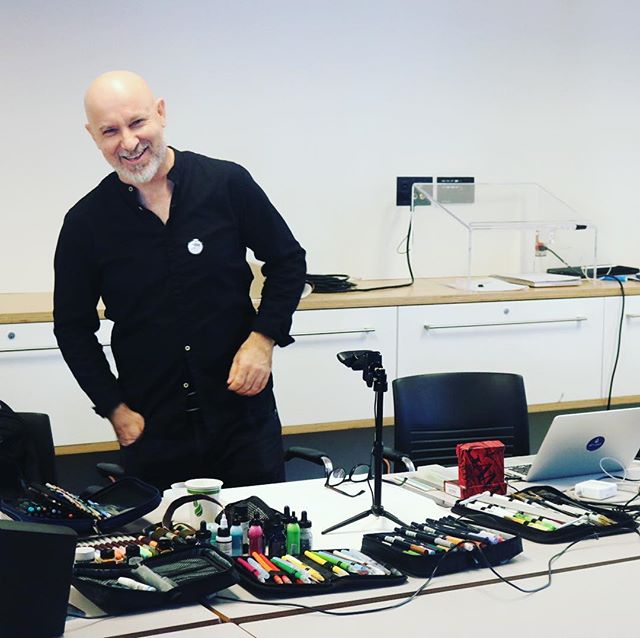
1. Why is your practice of Nomadic sketching important to you?
The most important aspect of my existence is to live creatively. Everyone knows it is not easy to be inventive every single (conscious) moment of the day, however with a dose of passion and a great deal of practice, it is possible to live creatively. My passion for the arts gave me a permanent thirst for learning and I’ve been immersed in studying and producing art for the past forty years. Today I feel even more impassioned then at the beginning, as I remain curious and open to change, to experiment and fail. Drawing brings the world to me, reminding me of the importance to be humble and open to learning.
 2. What do you think the impact of this practice has been on you as an artist, educator, and researcher?
2. What do you think the impact of this practice has been on you as an artist, educator, and researcher?The classroom is an extension of my practice and a polygon to test innovative methods and concepts. My ambition is not only to deliver the curriculum, but to generate a passion for lifelong learning. In order to stimulate students to adopt a creative lifestyle, I am obliged to provide a genuine example. In my case, both artistic and educational practices are intertwined through sketching. I have learned that failing is the most valuable component of every action. To draw means to be ready to fail, and I try to motivate my students to take risks and expand their perception, to explore ideas and materials and employ error to reveal unforeseen creative possibilities.
3. Why do you think others should engage with it?
In a world that is driven by materialism, success and competition, most people are afraid of failing. That is the reason they stay away from creativity and usually adopt a securer lifestyle, which turns them into submissive users. I believe imagination is the ultimate gift, with the capacity to fulfill all our goals. It is not the privilege of the artist to be creative. To be creative means to find new ways to think and make things, from cooking dinner to carving a sculpture. Every single human being has a talent, often suppressed or neglected. To discover and nurture our personal talent is the ultimate purpose of living.

4. What is unique about the sketching out in the world, as opposed to sketching at home or in a studio?
Despite the fact that I have a studio, I practice creative nomadism on daily basis. In fact, I combine both mobile and stationary creativity. I walk through the city with a camera in search for inspiration and rest in coffee shops to unpack my tools and draw. The most important aspect of sketching anywhere & everywhere is to stimulate the senses and expand the palette of perceptions. New places energize and channel creative energy that transforms the way we think. Most things are discovered by “chance”, which is nothing but an apparently insignificant impulse in the environment.
5. In your drawing-based research, you say "drawing’s ability to connect disciplines not because of its simplicity, but because of its capacity to interact with every medium, to illustrate and express, mimic and process idea beyond apparent (logical) meaning…" It sounds like your research suggests the power of drawing lies in its universality. The theme of the conference is the impact of drawing on the world. What kinds of impacts do you think this universality leads to in terms of actions?
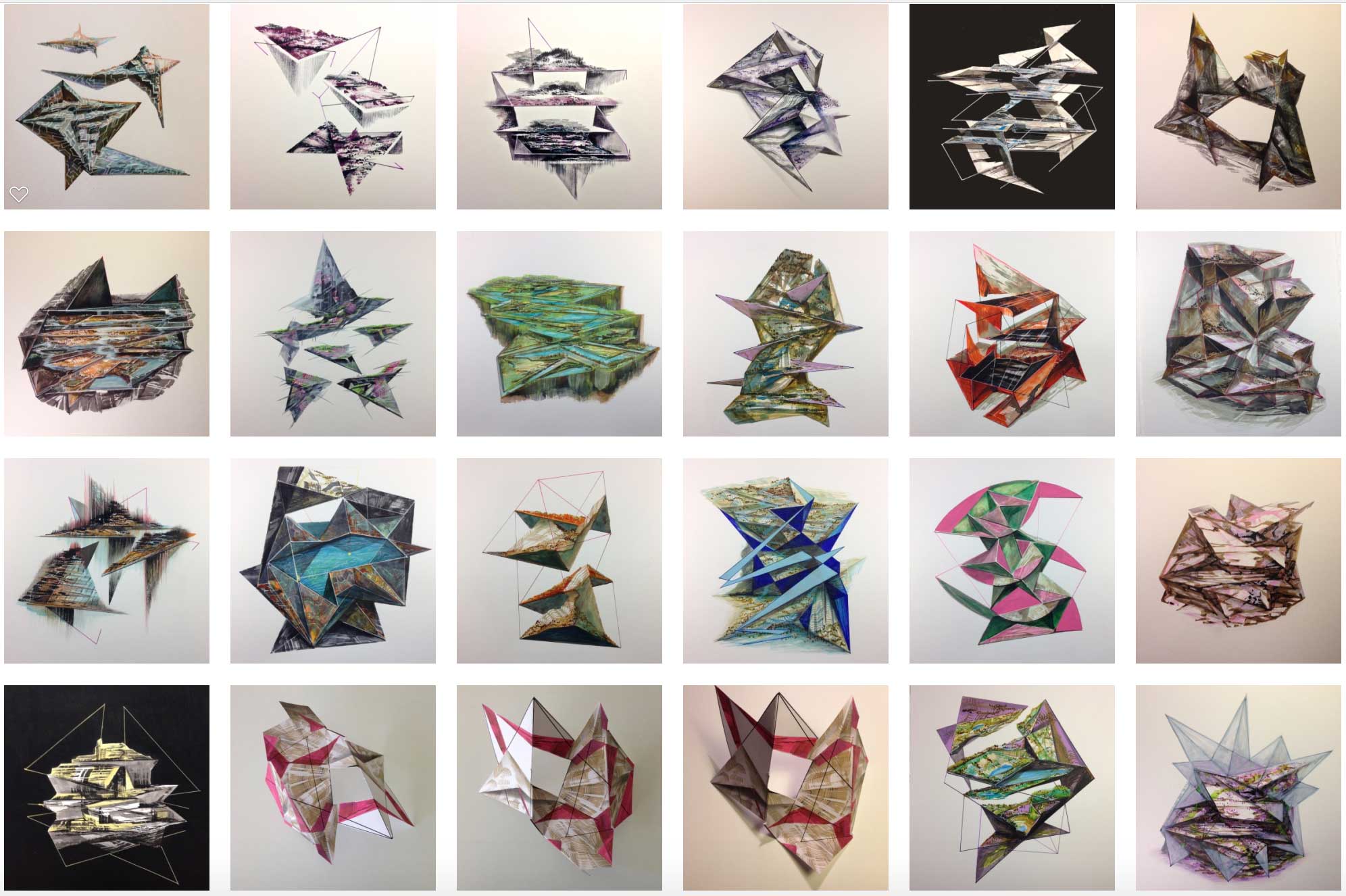
Divisions are the source of all troubles in the world. To make things worse, there is no solution to our problems, since nobody is responsible for any problem. Divisions generate fear and fear is the greatest tyrant over our lives, producing further disconnections. This vicious circle manages every segment of society, making everyone self-centered and isolated.
Our last solution is the integration of knowledge and resources. Culture plays an important role in every society and art has the power to join people from all segments of life. Due to technology and globalisation, languages are slowly but surely eroding into pictograms and symbols. By definition, the symbol is a “shortcut” to meaning and meanings are universal by nature. As drawing stands at the core of every art, it can turn ideas into actions. In this sense, universality comes alive via drawing and what else can better declare our presence on this planet, but a simple line which proves that we exist.
Photography + Pedagogy
/ Abstract FormsVjeko Sager
Sager is a contemporary artist whose series 'Antimatter' combines cut paper abstractions reminiscent of those by Francis Bruguière with charcoal drawings. Whereas Bruguière's images explore dramatic contrasts of light and shade, Sager's photographs are much lighter in tone. The cuts in the paper are mostly located in the central section of the paper. They tend be to be shorter and straighter, producing subtle disruptions of the paper's surface that remind me of architects' models.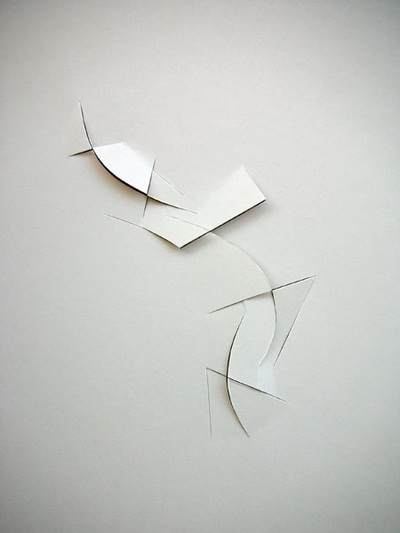
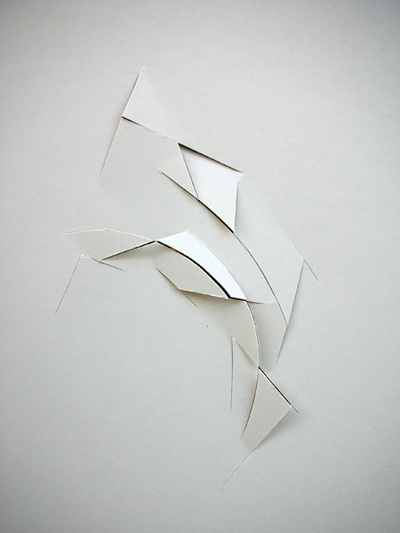
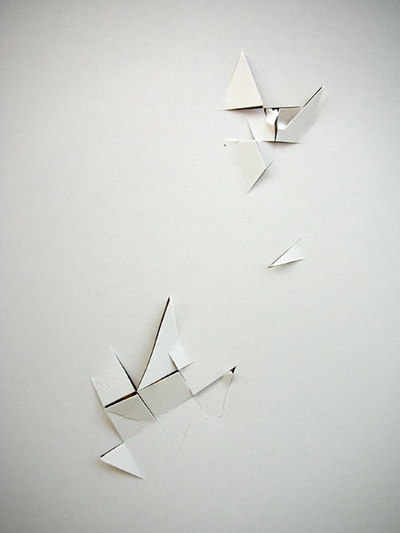
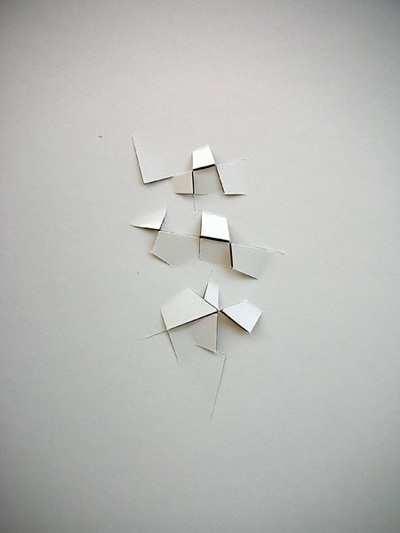
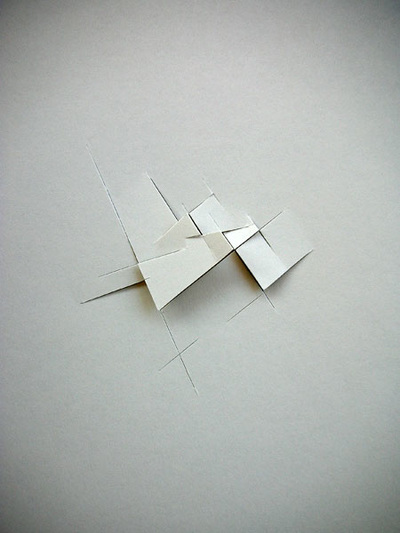
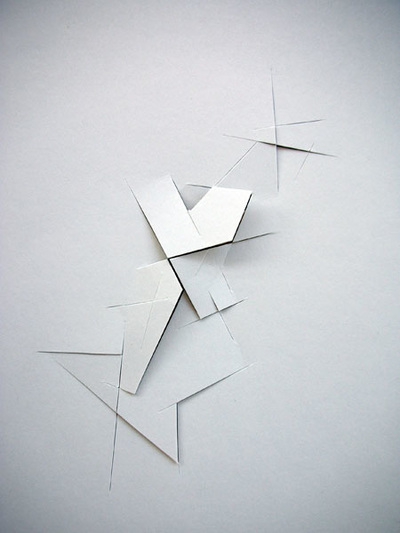
Architizer : architectural portal
/ Young architects GuideThere’s nothing wrong with the usual foamcore, chipboard or blue foam models, but there’s a whole world of ideas out there. Here are eight techniques to consider as you craft your next concept model at school or in practice.
1. Stack Paper
Sometimes all you need to elegantly communicate an idea is to use a single sheet of paper. Artfully folded or cut, paper can be an economical means of exploring a surface’s form (and not just the Gehry kind). Stacks of paper can be carved into or bound together, creating an unexpected feeling of depth.
 (Left) paper cutout by Vjeko Sager. Photo courtesy Vjeko Sager. (Right) Your House by Olafur Eliasson. Photo courtesy Osar.
(Left) paper cutout by Vjeko Sager. Photo courtesy Vjeko Sager. (Right) Your House by Olafur Eliasson. Photo courtesy Osar. PechaKucha : design platform
/ From Thorns To Stars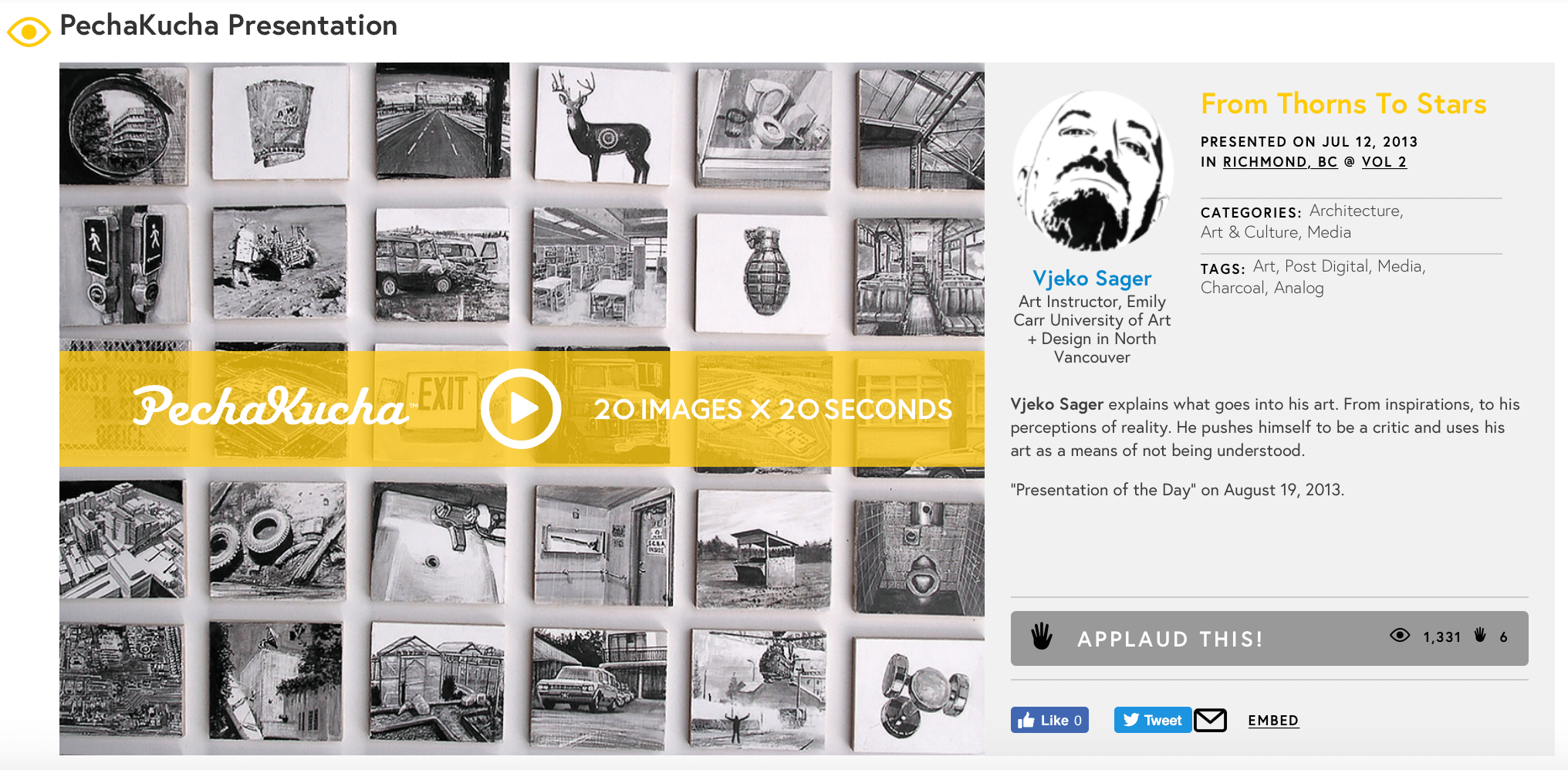
Richmond News
/ isolation through technologyArtist to share isolation through technology
Maranda Wilson , Special to the News / Richmond News Live feed from the diviNation tower at the Richmond Cultural Centre
Live feed from the diviNation tower at the Richmond Cultural Centre
Artist Vjeko Sager has a mind of his own and will use that to tweet, blog and livestream for a week from a tower in Minoru Plaza, starting Saturday, as part of the Your Kontinent film festival. Photo SubmittedVjeko Sager’s dream as a child was to live in a lighthouse.
The artist, philosopher, curator and teacher at The Emily Carr University of Art and Design was finally given the opportunity to live that dream — although not exactly in a lighthouse — when asked to be this year’s featured artist at Your Kontinent Film and Media Arts Festival.
After months of planning with members of Cinevolution and Your Kontinent, Sager will be holed up in a tower in the middle of Minoru Plaza, in which he will isolate himself for seven days. During this period of self-reflection, he will create art in the form of drawing and writing, and share those results through Twitter, blogging, and live stream video.“Maybe it was an unfulfilled dream,” joked Sager as he reflected on the lighthouse inspiration behind his idea. The task of the featured artist is to commission an original piece that intertwines this year’s festival theme of “Art, Technology, and Humans” with the artist’s own artistic accomplishments.
“As an artist, I am always interested in these subjects, specifically in the subject of how technology influences our activity today. I decided to use this technology as a bridge from me being isolated in a tower to communicate with the rest of the world,” said Sager.
The tower, which Sager named the “diviNation Tower” is a combination of the two words “divine” and “nation.” Sager will adopt a different persona for each day he’s in the tower, and that persona will guide the work to be produced. His personas embody the various stages of, what he believes is, his own personal evolution. From shaving his facial hair in different ways, to controlling what he eats, each persona will require a change in appearance, diet and behaviour.
“It’s going to create a feeling of a multiple personality disorder, and people will not be sure who I am,” said Sager.
Although staying overnight in the tower is a possibility, Sager doesn’t intend for his project to be a performance of endurance. Instead, he hopes the public can view his project as an example of how to use technology to transcend the moment, rather than just be users of it.
“I was collecting and editing myself, and my past years of writing, research, sketching, thinking, teaching are now fitting into some kind of flashback that, in seven days, I will see and present.”
This isn’t the first time Sager has put on a particularly unique exhibition. Known best for designing exhibitions around what he calls “utopian impossibilities,” this North Shore resident, who immigrated to Canada in 1994 from Montenegro, makes a personal pilgrimage every 10 years back to his home country in southeastern Europe to explore himself and his art. In his trip back in 2003, Sager tied himself to a rope and jumped into the ocean in an attempt to physically move a man made island.
Despite growing up in a small, but artistic, Mediterranean town, Sager avoided becoming an artist until he failed an exam in film and media studies at university. It was then he applied to the school’s applied art program and was one of six applicants in his year to be accepted.
“It must be destiny… it found me instead of me finding it,” Sager said. “My universe has been changed since, and I have never lived anywhere but in this world of art.”
Whistler Pique
NewsMagazine
/ essay on Your Kontinent Media & Film Festival 2014A tower of creative power
By Glenda Bartosh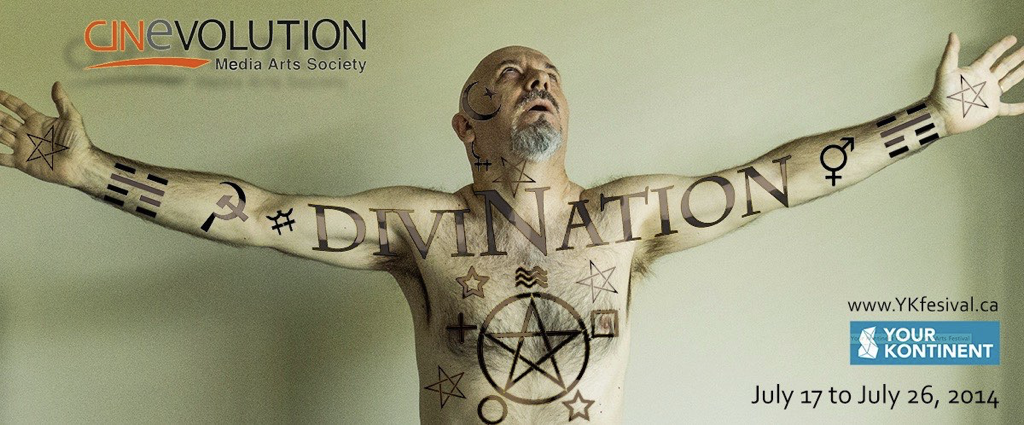 PHOTO BY AMONA RA
PHOTO BY AMONA RA- DIVINING THE CREATIVE Tribal Man is one of seven creative personas multi-media artist and Emily Carr instructor Vjeko Sager will assume during his seven-day drawing spree atop his 30-foot diviNation Tower at Richmond's Your Kontinent Film & Media Arts Festival
- Mountains; beauty; nature; a place of inspiration and solitude; a place to get away, and play and play and play. A place that's unplugged and definitely plugged in, in spite of itself.
Whistler is all of the above, and more: more than the sum of its parts, including the paradoxes and contradictions it's concocted for itself over the decades. And if there's one art event this summer that examines and connects to all of this — one you, in turn, can examine and connect to — it's Vjeko Sager's diviNation Tower.
A powerful multi-media artist with international reach — he earned his master's in Applied Arts at the University of Belgrade; his drawings are in collections around the world, including the Drawing Center in New York and the Museum of Modern Art; he curated CBC Studio's Art in Exile; plus he's been featured in Vancouver's PuSh Festival and Paul Wong's engaging Thru the Trapdoor — Sager is the featured artist at this year's Your Kontinent Film & Media Arts Festival in Richmond.
He's also been a frequent visitor to Whistler for the past 20 years since moving to Canada with his family from a beautiful resort in Monte Negro that could be a doppelgänger for Whistler. His father, a journalist with the top news agency in the former Yugoslavia, introduced him at a young age to friends like Ivo Andric, a Nobel Prize-winning author, and Vojo Stanic, a member of the Montenegrin Academy of Sciences and Arts who's exhibited at the renowned Venice Biennale, part of the Venice Film Festival.
With his homebase now established in North Vancouver and his studio in East Van, Sager calls Whistler his favourite escape.
"I've spent many weekends skiing, strolling, photographing and sketching at Whistler's cafes," he says. "I always find my favorite spots and turn them into my 'moving studios' where I work on the go."
To connect the dots between being human and art and technology in diviNation, Sager has built a 30-foot temporary tower in front of the Richmond Cultural Centre that's almost as high as the stately trees nearby. Part reality TV, part anthropological study of the creative process, Sager's project is centred on living and creating on top of his tower 12 hours a day for seven consecutive days — no matter what the weather. During that time, live streaming will connect him to our everyday world below, just like webcams connect us to those other-worldly events like baby eagles hatching or astronauts floating in space. In this case, our subject will be pondering, drawing and creating non-stop using a wide range of media while documenting his creative process and responding to real-time input on his work via tweets and blogs.
"I'm using my hand to write and draw, and I'm using my phone to make recordings, videos, photos. I'm using a computer. I'm using my fingers to draw in the sand — everything which allows me to become creative is my tool," he says.
"I don't find computers any different than making marks in the sand."
Each day of the week-long creative journey, Sager will assume a different persona — from a techno geek and ordinary guy to a rebel/anarchist, a philosopher and a spiritual person. About 60 per cent of his project will be curated; 40 per cent will be shaped by his viewers and audience. Each persona will determine the clothes he wears, the food he eats, the nature of the artwork he produces, and the media he chooses to create it with. It all symbolizes "how an ordinary person who uses technology learns, evolves and is transformed by the psychological, philosophical, physical and mental work of creating," a considered theme in his art practice and teaching.
"In Greek, 'persona' means 'mask,' so when we talk about personas we talk about masks," says Sager, who's taught at Arts Umbrella and Vancouver's International Children's Festival and is currently an instructor at Emily Carr University of Art and Design. (When Emily Carr brings some of its programs to Whistler, he could be your instructor; Sager often teaches ECUAD's new courses.)
"The most interesting aspect for young people is that they have more than one persona. So they can start exploring the different aspects of their personality and turn that into creative acts. You can use videos, drawings, words, movement, dance, even sports to explore and express those personas."
The problem, he explains, is the everyday demands of society usually confine us to one persona. By contrast, the idea of carnival, with its associated masks, was created to release our locked-up inner selves. Take World Cup or Olympic celebrations when people dress in team colours and paint their faces to match; Carnivale, Mardi Gras, even Whistler's Children's Art Festival and Halloween let us release other personas.
"When we suppress them (personas), they can become violent and eruptive and uncontrolled. So I believe creativity is the best way to try them out, give them a chance to express themselves — definitely for kids I believe it's better than anything else," he says.
Another aspect of Sager's diviNation Tower is meant to show that creativity is rooted in something quintessential to Whistler, something he himself enjoys when he visits — the idea of playing and just being free.
"When we think about games, they all have rules. We can win or lose," he says. "But with play there are no rules. I think creativity is playful, without any boundaries or any rules. When you start playing in the sand, you don't expect to have end results. It's going to vanish the next day.
"...Probably that's one of the reasons we are scared of creativity, because we expect a finished product. For kids it's very, very important to remove the fear of finishing anything."
diviNation also speaks to solitude. It's inspired partly by a dream he's had since boyhood to be a solitary lighthouse keeper, and partly by the stylites — saints and ascetics of the ancient world who lived atop pillars to transcend the ordinary world (One stylite in Syria lived on his pillar for 37 years!).
"When I was a boy, I had my world and I enjoyed it immensely," he says. "If I was not alone daily I would really suffer as a person.
"I'm sorry to say it, but sometimes in our society, aloneness and solitude are treated as a negative. But that is the most wonderful human aspect because if we cannot be alone, we cannot be human," he says.
In fact, he believes one side of our personality, the creative side, needs to be isolated to incubate ideas, so they can carefully grow, protected, "until they gain some force, some life of their own, and then they become public."
Just as they will in real time on diviNation Tower.
RICHMOND'S YOUR KONTINENT MAPS OUT NEW FILM & ART BOUNDARIES
You don't have to be a filmmaker or an artist to appreciate Your Kontinent Film & Media Arts Festival in Richmond. You just have to be excited by creativity and the idea of an international, integrated world.
Now in its fourth year, Your Kontinent is based on the idea of Urkontinent, a term coined by German scientist and geophysicist, Alfred Wegener, for Earth's first continent — a single, unbroken landmass. The festival reflects the vision of an integrated, socially cohesive society that not only accepts, but embraces, difference.
Featuring more than 30 local and international films, over 100 multidisciplinary artists and the latest, cutting-edge digital media experiments, Your Kontinent also highlights an artist each year whose practice has contributed significantly to media arts in Canada. Besides this year's Vjeko Sager, featured artists have included Paul Wong (2011), Margaret Dragu (2012), and Dana Claxton (2013).
The Source
/ Volume 15
Translating sensations at Richmond film and media arts festival
BySimon Yee // Culture, Festivals // Volume 15, Issue 2 - July 8 -- August 26, 2014
Vjeko Sager says true art is a style, an immersive experience. | Photo by Simon Yee
Local artist and Emily Carr University instructor Vjeko Sager believes art is an external and ineffable idea comprehended through an immersion of spiritual sensations and the artist is a performer who is responsible for the translation of those sensations. From dawn to dusk, Sager will translate those sensations from atop Divination Tower, the featured exhibit of Cinevolution’s Your Kontinent Film and Media Arts Festival, from July 17 to 26 at Minoru Plaza in Richmond.
“The highest level of artistic creativity is to figure out what the idea wants to become, not what the artist wants it to become,” Sager says.
Classical aesthetic theory, such as those advanced by the 18th century aesthetics thinker Alexander Baumgarten, privileges sight and sound, provided by the eyes and ears, as the only senses capable of understanding beauty and art. The other senses are relegated as primitive as they are only needed for survival. Sager believes otherwise: all the senses are needed and essential to access and translate art.
“The biggest problem today is that the eyes and ears are the easiest to trick and we have the trickery interpreted as art,” says Sager. “True art is a style, an immersion. I find artists today focus too much on the tools of art, not on the art itself.”
Art that is interpreted as entertainment, as therapy, or as the output from the latest technological gadget becomes banal or novel and is, for Sager, a misuse of art. And art instruction that focuses too much on photo editing, camera settings, sound mixing, and other manipulations detracts from experiencing art itself. According to Sager, the artist’s challenge is to minimize degrading the artistic idea when trying to communicate with those tools.
“Tools limit art, and the emphasis on tools today is what I grieve,” Sager says.
Sager finds inspiration through provocateurs, iconoclasts and thinkers who challenge the status quo and established dogma. He counts figures like Nikola Tesla, Søren Kierkegaard, Friedrich Nietzsche and the Slovenian cultural theorist Slavoj Žižek among some of his influences.
“I lived in Montenegro and Žižek lived in Slovenia (at the time, both socialist republics of the former Yugoslavia), and he was a formative influence on me. He collaborated with some of the most avant-garde musicians and artists in my old country, such as Neue Slowenische Kunst. Žižek doesn’t subscribe to any rule, he breaks them all,” says Sager.
Sager sees these rule-breaking acts as true expressions of one’s own unique and ultimate humanity, qualities that are vital for accessing and discovering art, truth and beauty. Although Sager doesn’t see himself as an iconoclast, he hopes his artistic journey on Divination Tower re-emphasizes the artist and its poiesis, the act of being creative.
“In this project, I will be portraying seven personas to show how humanity can progress from being technologically imprisoned to a spiritual being,” says Sager.
Clothing, diet, behaviour, thoughts, attitudes and the means of creation vary with each persona, which in turn influences the sensations that are felt, the art work which is produced and the messages that are relayed.
“In our everyday lives, we usually subscribe to one persona, and we don’t allow ourselves to experience different attitudes. The project is called Divination, because I view it as a prophecy of what has happened to humanity and what can happen,” says Sager.
Sager will unveil the Tower and help open Your Kontinent’s Film and Media Arts Festival, which showcases digital and media artists from diverse backgrounds. Film screenings, theatre performances, light shows and youth programs are among some of the program highlights. The theme of the festival is the connections between humanity, art and technology, which encourages festivalgoers to rethink their relationship with technology amidst technology’s isolating, connecting and globalizing forces.
© Vjeko Sager :: all rights reserved
